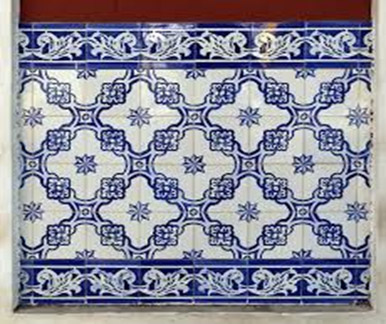
Exclusive to Goa, the art of azulejo, or hand-painted ceramic tiles, came to Goa with the Portuguese. Birthed in Arabia and named azulejo, smooth and blue, or small polished tile, nowadays made with traditional and modern techniques, the art and craft of azulejos were brought back to Goa by Orlando de Noronha. He went to Lisbon, Portugal, to study the Portuguese guitar, and returned with a bagful of tiles and a book about azulejos. He is single-handedly responsible for the revival and popularity of Goan azulejos. These blue tiles, which narrate tales, new and old, have become an integral part of Goan identity. From the Arabic designs comprising geometric and floral patterns, to the curvy ones of Spain and Portugal, the azulejo developed through the ages before coming into Goa and becoming part of the artistic repertoire of the state. Goa made azulejo painting its very own, and now the more popular motifs are rural and urban Goan life, the fisherwoman, boats and churches etc. Traditionally, blue and yellow colours were favoured for the painting now, all colours are used. You can spot the traditional Portuguese tiles at the Menezes Braganza Hall in Panjim, painted by Jorge Colaco, and the Old Goa church at Chinchinim and other similar ancient heritage spots. The modern versions are visible all over Goa.
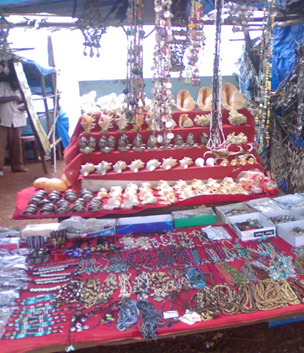
Seashell Craft or the Shimpla Hast Kala craft of Goa is a fascinating art form that combines seashells with various materials to create stunning and intricate items. The artisans skilfully arrange the shells in different patterns, incorporating materials like brass, plastic, wood, and horn to add depth and complexity to their creations. The resulting products range from screens, boxes, and mirror frames to exquisite pieces of jewellery. The roots of shellcraft can be traced back to ancient times, with historical evidence of exquisite conch shell items found in Sri Lanka. These include remarkable pieces like the hak-gediya, a shell trumpet adorned with engraved designs filled with red lac and mounted in brass, as well as the jayasaka, or shank of victory, a precious trumpet mounted in gold, dedicated by King Rajadhi Raja Simha after he triumphed over the Dutch. This practise is popular in the Panaji, Porvorim, Mangueshi, and Mandrem districts in the north and Madgaon in the south.
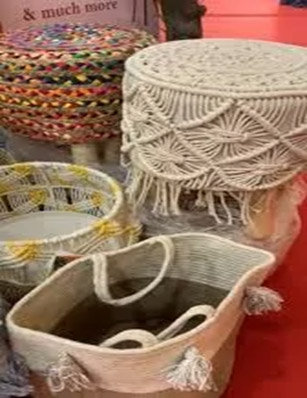
Jute craft is known to be one of the most unique crafts of India and items such as decorative bags, belts, wall hangings, lamp shades, flower pots, hangers, etc are popular Goan souvenirs. As an art form, it has been around since at least the 13th century, when Arabian weavers started knotting the extra fabric at the edges of loomed fabrics. The loose nature of macrame knots mean that a special technique is used to keep the knots in place while the work is being done, Macrame is actually an art that complements many styles, and its distinctive knots are often seen on retro fashions and decorative houseware. Making macrame items involves just a few materials and embellishments. A knotting board, scissors, some rolls of twine or hemp, a tape measure or ruler, and beads for an optional finishing touch are all it takes. The cord, is mounted to the knotting board before starting to make the knots. Three common knots used in macrame are square, overhand and double-half-hitch knots. Rings can be incorporated into the knots to form a plant hanger or piece of wall art. Beads, feathers, buttons, rings and shells add a decorative touch to the piece.
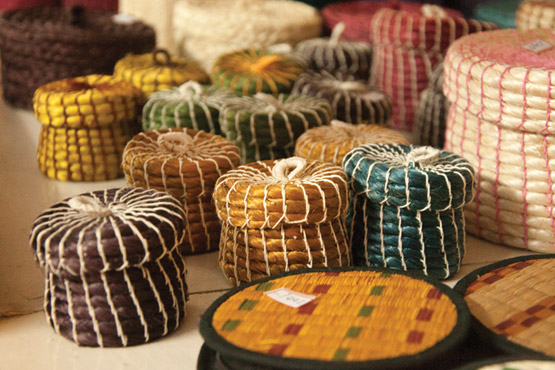
Traditionally, the Mahar community makes bamboo products that are used by fishermen for functional purposes. Bamboo is locally available, in Pernem, Tiswadi, and Sattari districts of Goa while the craft is practiced in the South Goa districts of Madgaon and Cuncolim; and the North Goa districts of Porvorim, Pernem and Mangueshi. The products are available in the weekly marketsx across Goa. To craft the bamboo the craftsmen soak the bamboo for two or three days in sea water for seasoning, it is then sun-dried. When completely dry it is segmented. The outermost layer of the bamboo or skin is removed completely. The pith inside is removed and used as fuel. The bamboo is then cut into strips. These strips are further cut into splits that are used for weaving the basket. The baskets are made only with the inner part. The tools used are basic and include the Koyo-large knife and the Sun or small blunt knife. To colour the splits, chemical colours are boiled in water, and the strips are left in this solution for half an hour and dried. A huge range of utility products like baskets, boxes, flower vases, winnowing trays, chicken baskets, grain baskets, partitions, fans, and mats are made from bamboo strips in Goa. .
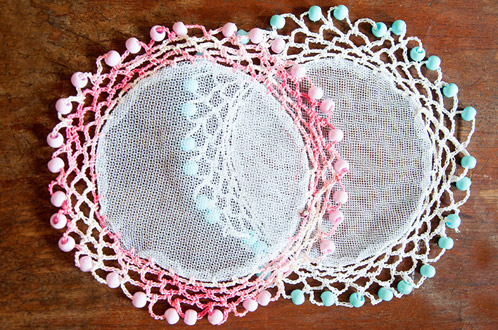
A craft believed to have been introduced to Goa by the Portuguese nuns, Goan crochet is a tradition practised today primarily by women in North Goa, especially the city of Panaji. The origins of crochet are debated, but it became popular in Europe during the Renaissance. In Goa, crochet production, alongside was fostered by missionaries and other colonial agents. Crochet was initially used to make religious garments for the clergy, and as decorative elements in worshippers’ clothes. Goan crochet uses different techniques for different textiles. The motifs depicted are often reminiscent of Goan life and culture, such as the commonly-used mandala design, valued for its symmetry and used as a symbol in both Hinduism and Christianity, found elaborate crochet garments. Filet crochet, a technique used to depict intricate images and symbols with a lightweight yarn, is used to decorate tablecloths, curtains and scarves. Goan crochet has historically functioned as a cottage industry. Designs and stitching preferences vary from village to village, or even between households. Historically, prospective brides wore clothing which they made fully or partially with crochet as a way of displaying their skill with the craft. Crochet items were also presented as dowry during the colonial period.
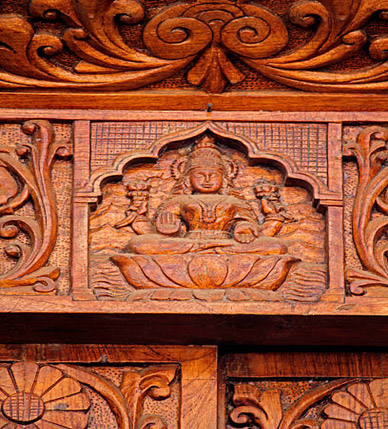
Goa's rich tradition in woodcarving locally called KasthaKari is visible in churches, temples and traditional houses there. The Portuguese influence is shown in the Portuguese-style furniture made and the carvings in the churches and cathedrals. Wood carving is traditionally done by the Suthar and Badhai community. Teak, rosewood jackfruit and jungle wood is obtained from the densely forested area on Canacona, the southernmost region of Goa and Sanguem taluka. All kinds of products continue to be made from interiors, exteriors, roofs, all kinds of furniture, doors and windows, objects like mirrors, boxes etc. Carved motifs include grapes, lotus, peepal leaf, palm leaf, surajmukhi or sun faced panels. The pattern is transferred to both sides of the block with the help of a stencil and a chalk, and carved. The carving is done entirely manually using chisels and hammers.
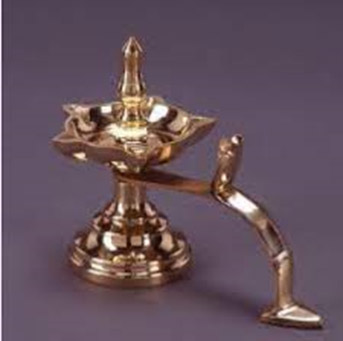
In Goa the Kansara community make the brass lamps locally called Otim Kaam used for religious ceremonies and festivals in temples among several other products made for the tourist and the local market. This tradition of brass lamp making is spread across the west coast to Kerala and Karnataka. The ritual lamps made range from heights of small to unusually tall and are a distinguishing aspect in the Goan temples, including in the famed Mangueshi and Mahalsa temples. Lamps used in worship are elaborate including three tiered ones.. Niranjan, the brass lamps; Samala the large lamps; Kalash the ritual pots; Tapli small vessels, the Kahlbatt mortar and pestle; Peep the small vessel for water; Attar dandis or perfume sprinklers; diyas, candle stands, sevanazhi – a screw press for making vermicelli and other such brass products are usually created through the casting process. In the case of large lamp the various parts are made separately and then assembled together. The kansara community can be found practising their craft in Mapusa, Sanquelim and in Bicholim.

Kumbhar pottery is a traditional art form that traces its roots to antiquity; one of the earliest and oldest professions in Goa, the craft has sustained itself through the centuries (including under Portuguese rule)and is flourishing even today. This form of red clay pottery has manifested itself across various Indian cultures over the years, and in Goa, its making can be witnessed in the areas towards the north, such as Bicholim, the adjoining areas of Bardem and Mayem, and Calangute. The pottery is both utilitarian and decorative, with pots, bowls, storage containers, plates and vases being produced alongside lamps, idols, sculptures, figurines and masks. The word kumbhar finds its etymology in the Sanskrit word kumbhak, which means ‘those who make earthen pitchers'. They form the potter caste in the Hindu caste system, and the preservation of tradition has allowed them to claim pottery as a hereditary and largely monopolistic occupation through the years. Goan and Maharashtrian Kumbhars are not found across Goa, but rather are scattered in individual regions in their own ‘wards’.This is largely due to the availability of resources, in this case, red clay. Interestingly, while men use the potter’s wheel to help shape the clay, the women of the community customarily must only use their hands to shape the ware.
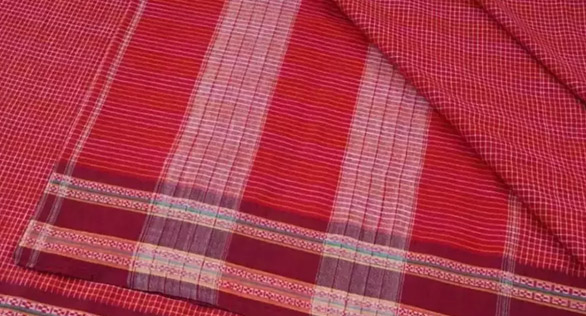
Goa's renowned Kunbi saree, named after the indigenous Kunbi tribe, is a symbol of the state's cultural heritage. With a plain body and vibrant, handwoven border and pallu, the saree reflects the Kunbi community's expertise in traditional weaving techniques. Crafted using locally sourced cotton and silk threads, the labour-intensive process includes a tie-dye technique called Bandhni, this technique involves tying small portions of the fabric with threads before dyeing it. Once dyed, the tied sections remain uncoloured, creating mesmerizing patterns. The Kunbi community primarily uses cotton and silk threads to weave these exquisite garments. The weaving process can take several days, and it often involves a collective effort within the community. The beauty of the Kunbi saree lies in its simplicity. The body of the saree allows the vibrant border and pallu to take centre stage. The borders are usually adorned with motifs that depict elements from nature, such as birds, animals, flowers, and trees. These motifs not only add aesthetic appeal but also reflect the deep connection between the Kunbi people and their natural surroundings. During weddings and other significant celebrations, Kunbi brides often don the sarees as a mark of respect for their roots and ancestors. The garment’s vibrant colours and intricate patterns make it a standout choice for such occasions, reflecting the joy and vibrancy of these moments.